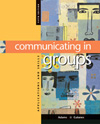The Internet is a collection of interconnected computers that allows information to be communicated electronically around the world. Common uses of the Internet include the sharing of information using Web pages, communication among large groups of individuals using bulletin board systems, and personal communication using electronic mail. Although the Internet was initially formed for task purposes-to facilitate strategic military communication-it has now become a useful tool for creating and sustaining primary groups. Communication researcher Kevin Wright has studied the effectiveness of the Internet as a method of obtaining social support from others-a characteristic of primary groups like families and friends. Wright explains that Internet-based support groups allow 24-hour access, anonymity for participants, and opportunities for connecting with other individuals encountering problems similar to our own. What is your opinion about using online groups for personal support? What advantages or potential disadvantages do you think are most important? You can search for online support groups by using any of the popular search engines such as Yahoo! or Excite. There are also websites that contain message boards for a variety of self-help topics. One such website is the Mental Health Net site, which may be accessed through the following address: http://community.mentalhelp.net/forum/newforums.html SOURCE: K. Wright, "Computer-Mediated Support Groups: An Examination of Relationships among Social Support, Perceived Stress, and Coping Strategies," Communication Quarterly 47 (1999), pp. 402-14. | 


 2003 McGraw-Hill Higher Education
2003 McGraw-Hill Higher Education